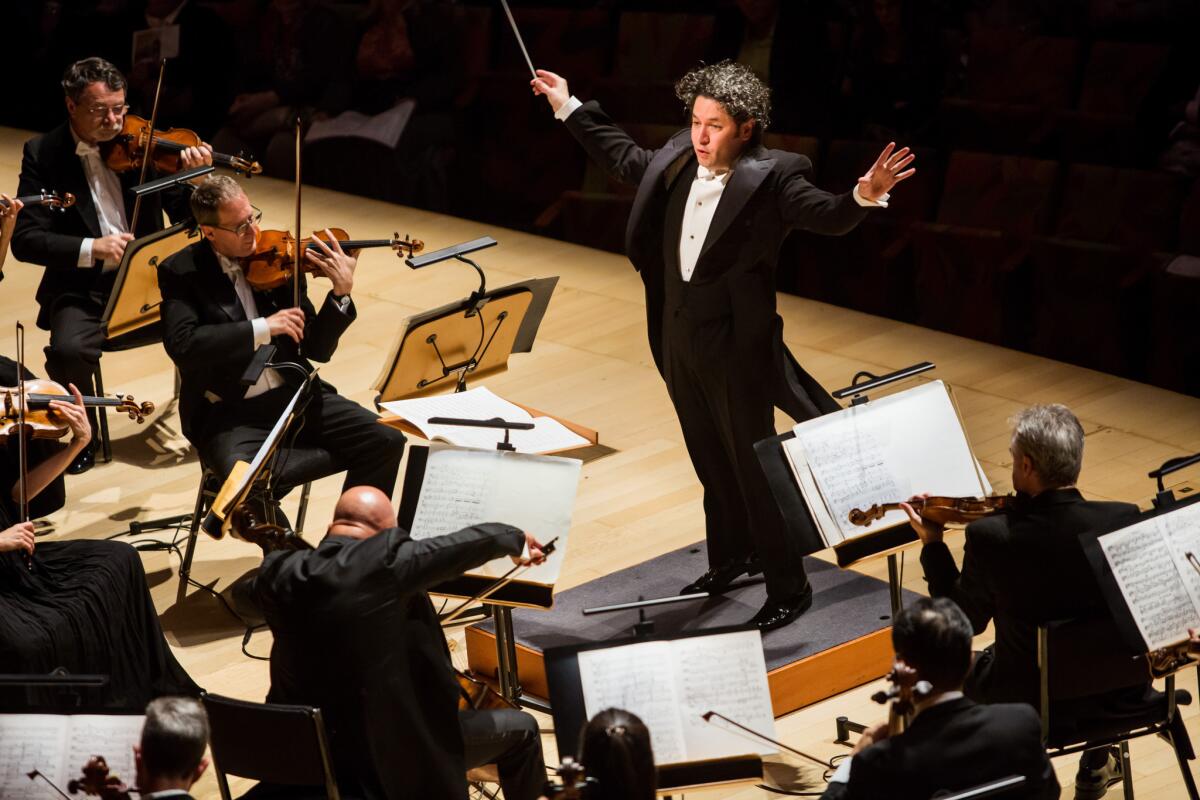Review: Generous renditions of Mendelssohn and Bach balance youth and experience

Gustavo Dudamel conducts the LA Phil in Benjamin Britten’s Young Apollo, Op.16, at the Walt Disney Concert Hall in Los Angeles, Calif., on Nov. 27, 2015.
- Share via
It is an eternal, oft-noticed predicament that the old make the best connoisseurs of youth’s flawless beauty, whereas geezer experience has a special enticement for the young. Be generous, an aging composer in Paolo Sorrentino’s new movie, “Youth,” asks of a young actor when inquiring about his background. Be generous, the actor urges when wanting to know what it was really like to hang out with Stravinsky.
Gustavo Dudamel has made Mendelssohn’s First Symphony the major symphonic work of this week’s Los Angeles Philharmonic program. It was as if the once precocious, now highly experienced conductor were asking a composer who was young enough to be his son about the root of his own precocious genius.
That experienced conductor at Walt Disney Concert Hall on Thursday night may have been only 34, but he’s been around the block. Mendelssohn was 15 in 1824 when he wrote his Symphony No. 1 in C Minor, Opus 11.
SIGN UP for the free Essential Arts & Culture newsletter >>
This is not a standard repertory symphony. It hardly ever shows up on a concert program or recording unless it is part of a cycle of Mendelssohn’s five symphonies, and the L.A. Phil never got around to it until 2009, when James Conlon programmed the symphony as part of a Mendelssohn celebration.
We, instead, tend to hang on the romantic notion of a Mendelssohn emerging a fully formed great composer at 16 with his ravishingly beautiful Octet, followed the next year by the popular, perfected jubilation of his Overture to “A Midsummer Night’s Dream.”
These appear to be unbelievable accomplishments without knowing this First Symphony, an imperfect score that was treated like a masterpiece in an extraordinarily graphic performance by Dudamel that went straight for the source of what would make Mendelssohn Mendelssohn. But the equally great value of a performance this convincingly good of immature music was in vivid appraisal of what would be still required to make Mendelssohn Mendelssohn.
The symphony is bursting with ideas that sound like no other composer, such as the honeyed melodies, the fairy-dancing scherzos and the build-up of energy to the flavorful bursting point. But the teen composer only partly knew what to do with any this. Sure, a showy fugue is impressive at the end, but why and wherefore? In the songful slow movement, Dudamel underscored rapt woodwind counterpoints that are easily ignored in the too-thick textures of a composer wanting to do it all. But they are sheer inspiration — inspiration he clearly didn’t realize he had.
The program, which might have seemed on paper one of Dudamel’s least imaginative, began with more 15-year-old Mendelssohn. There are slight hints of midsummer magic in the 10-minute “Overture for Harmoniemusik” for wind band before it enters into a spirited um-pah-pah mode. But every original idea is completed by a cliché.
The middle section of the evening was turned over to Bach’s two extant violin concertos, for which Dudamel used a very small string section and inaudible harpsichord (inaudible harpsichords being all the rage at concerts this fall). Gil Shaham brought his usual boyish enthusiasm to the solo tasks.
These concertos couldn’t be more familiar, although they are more commonly handled by chamber orchestras or period instrument ensembles. The chamber and early music approaches were honored. Tempos were brisk. Dudamel asked for lightness of touch and crisp rhythmic articulation consistent with our ideas of Baroque period practice.
Shaham’s playing was, as ever, gorgeous; his tone, creamily warm; his embellishments between sections, smoothly virtuosic and tasteful; his love for every Bachian turn of phrase made apparent. But he may have been overly agreeable. The lesson Mendelssohn would one day learn from Bach is that of musical implication. A good melody or theme is a very nice thing, but what you do with it is what matters. You want the pudding, and you want the proof.
Shaham was sensational with the pudding. Everything flowed with a slippery ease that suggested he had rubbed his bow with Vaseline rather than rosin. He played as one with the small orchestra, not in conversation with it, a tactic more useful in the E Major concerto than the A Minor.
Shaham’s new recording of Bach’s solo violin Sonatas and Partitas takes a more substantial attitude toward musical proof, with a great emphasis on articulation, architecture and development. But when sandwiching the concertos between more structurally awkward early Mendelssohn, Shaham may have worried about seeming pedantic. His generous display in this case, then, was not to show Bach’s exceptional rigor but the Bach who wrote with seeming natural ease. That is precisely what, in preciously record time, would become Mendelssohn’s most endearing trait as well.
More to Read
The biggest entertainment stories
Get our big stories about Hollywood, film, television, music, arts, culture and more right in your inbox as soon as they publish.
You may occasionally receive promotional content from the Los Angeles Times.











